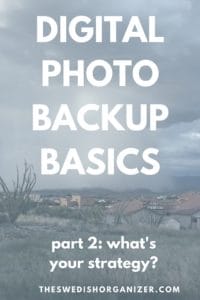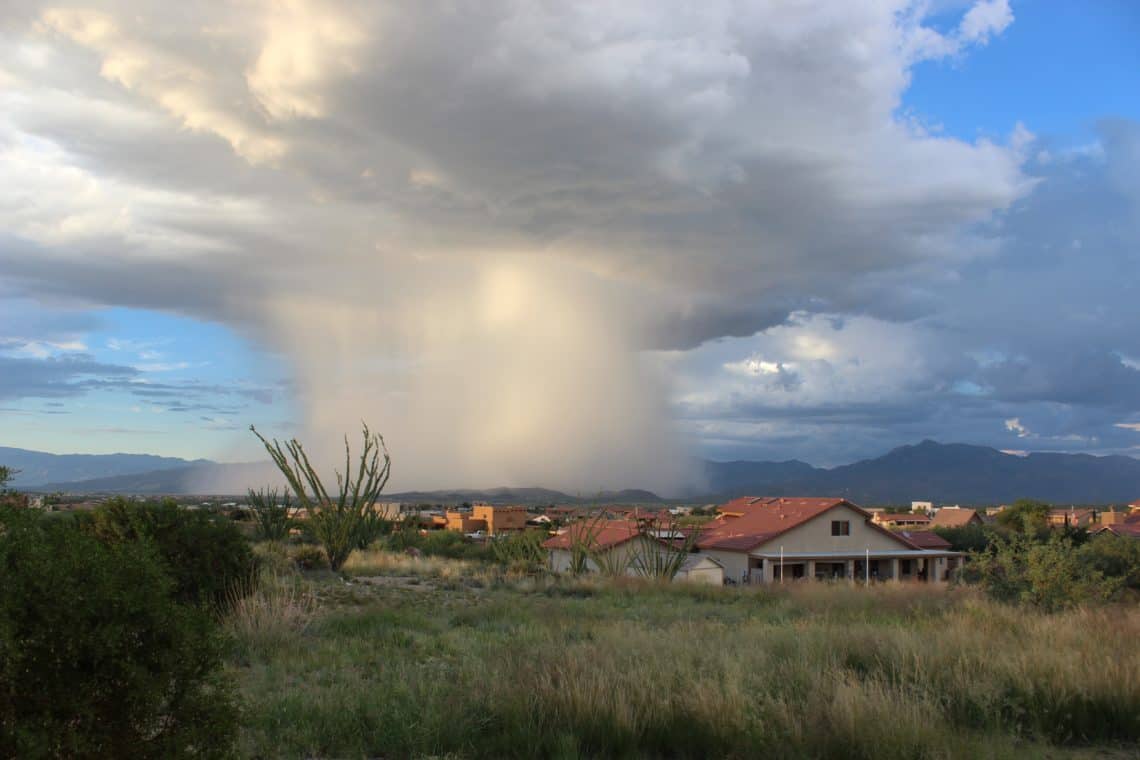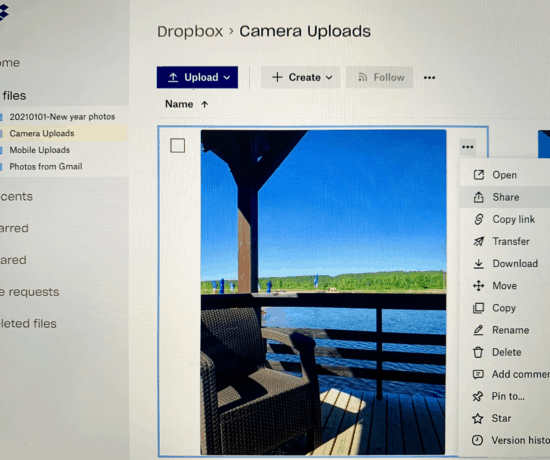Welcome back to this series on backing up your memories! In this post, we’re tackling how to develop a backup strategy that you can implement, and actually remember! I do recommend that you start by reading part one, so if you haven’t yet checked out my post about the different types of backups you might come across, click right here!
What’s Your Backup Strategy?
Now that you understand some of the different types of backups, you need to pick a backup strategy for your memories. This is the overall workflow that guides your backup decisions, so if you don’t have one yet, put creating one at the top of your to-do list right now. You need to have a plan for when to backup, how to backup, and where to store the backups, so that if something goes wrong, you can go into recovery mode quickly. It may seem like an unnecessary step, but just like in any organizing endeavor, having a plan is game-changing.
Creating Your Own Backup Strategy
So how do you pick a good backup strategy?
Start by defining where you main photo hub lives, and then work your way outwards towards other devices and systems.
A backup strategy doesn’t have to be complicated, but it’s a good idea to have it written down (perhaps in your organized household / family binder?), in case someone else needs to access your memories at some point. Your backup strategy should answer the following questions in detail:
- Where is the main Digital Photo Hub (DPH) located?
- What is on the main DPH, and in what format?
- How often is the main DPH changed, and how?
- Where is Copy #1 stored, and in what format?
- How can Copy #1 be accessed (cloud, address, passwords etc.)?
- Where is Copy #2 stored, and in what format?
- How can Copy #2 be accessed (cloud, address, passwords etc.)?
- How often are Copies #1 and #2 Updated?
- Is there a specific schedule for backups?
Creating a backup strategy sounds like a lot of work, but it’s not that bad. It’s really just a few sentences that defines the workflow you have created. I feel it’s important to write things down because it forces you to get clear on what you’re doing and why. The good news is that you don’t have to start from scratch. There are plenty of ideas out there in cyberspace that you could borrow from and make your own. The most common recommendation is the 3-2-1 method.
What Exactly is the 3-2-1 Method?
The 3-2-1 method is a a strategy that long has been touted by the U.S. Government as the best way to backup your personal files. Most backup services recommend it, as do most institutions.
Here’s the gist, as quoted in a report by the Department of Homeland Security:
3 – Keep 3 copies of any important file: 1 primary and 2 backups.
2 – Keep the files on 2 different media types to protect against different types of hazards.
1 – Store 1 copy offsite (e.g., outside your home or business facility).
In a nutshell, your files should live on a Master (i.e. your digital photo hub) and you should create two separate copies, one of which needs to live elsewhere.
I think the 3-2-1 method is a good general starting point. An example of a good setup would be a main computer, two external hard drives made by different manufacturers, one using an automated backup system (like Time Machine), and the other one being reserved for manual backups. Both drives would then be stored in two different places, away from the main computer. Extra points for adding a cloud backup, which is easy (and nowadays not very expensive). Maybe you already have a similar system going on at home, but you just haven’t made it official?
Different Media, or Different Devices?
The hardest part of applying the 3-2-1 method is deciding on which two media types to use. It’s no secret that I prefer external hard drives over other storage options, so my own strategy involves multiple hard drives. In my opinion, there are few storage media options that can rival external hard drives in terms of capacity and reliability, so rather than picking two different formats, I use different devices instead. Sometimes, you have to interpret these guidelines your own way.
So should you pick two different media, or two different devices? Only you can decide, but try to keep your entire collection together in one piece. You want to be able to stay organized, so scratch DVDs, CDs, BluRays, and flash drives from the list. No matter how great the quality is, they just don’t have the capacity, not to mention that they can easily break, scratch, and get lost. Also important – DO NOT open multiple free 2GB cloud storage accounts just to avoid the monthly charge. You will just end up confused as to where a certain photo is stored. From an organizing standpoint, you’re better off keeping everything together as one complete backup.
What Does Off-Site Really Mean?
The idea behind the off-site part of the 3-2-1 strategy is to have the devices stored in different places in case something happens to the first location. We’re talking fire, theft, natural disaster – use your imagination. This is a conundrum for many people who may not have access to second location, so you’ll have to do your best here. The question then becomes: what location is safe enough? I usually recommend having at least one backup stored in a different city, state, or country. Why? Because if a tornado shows up, it usually destroys the entire town, not just one home. This will vary based on where you live, so make an educated guess on what dangers your memories face.
For me, it’s easy. I store some copies in my office in the U.S., and some copies in my office in Sweden. That’s about as far apart as it can get. The downside is, of course, that I have to remember to update them when I travel. They aren’t as easily accessible to me at all times, but knowing that I have family members with computers who can access it all, makes me feel pretty confident about this arrangement. You have define what off-site means to you. If the best you can do is safe-deposit box in your home town, that’s better than keeping everything at home.

Pin This Image!
Should You Backup Manually, or Automate?
There are two different schools of thought on this, and it varies based on who you ask. The first one argues that human errors happen more often than computer errors, so you’re “better off” automating everything and not doing any manual backups yourself. No humans, no mistakes. The other side argues the opposite: that you have more control with a manual backup, and will remember more clearly what’s backed up where. Technology is unreliable, and who wants to fully trust their computer?
I use a mix of both. This may surprise those of you who know me well because I’m always in favor of automating as much as possible in order to stay productive, but I actually don’t advocate skipping manual backups. In fact, I do many manual backups in my business – all the time. Is it a perfect system? No. It takes time, but I feel like I have more control over the backup when I do it myself rather than leaving it all to my computer.
Now, don’t get me wrong. I love using automated systems too, and that’s because I have a lot of data to backup. I care for both my own memories, any many of my clients’ memories as well, so I have to err on the side of caution. Plus, it’s nice to know that even if I forget, my computer backed up everything automatically. It can get confusing knowing which version is the most current one, but I solve that problem by labeling my hard drives in great detail (with dates), and completing all of the backups at once.
My Recommendations Vary
I don’t recommend the 3-2-1 method for all clients because I feel it depends on their needs. What files do they have? Are those files important? Can they live without them? If the answer to the last question is yes, then the 3-2-1 method is overkill. If the answer is no, then I don’t believe the 3-2-1 method is enough. If they have priceless photographs, then we choose a customized backup strategy based on what they tell me. It might be the 3-2-1 method, but more often than not, it’s more like a 4-4-2 system.
Will the 3-2-1 Method Work for You?
The 3-2-1 method is not for everyone, so you might come up with something different. You have to figure out what type of strategy will work for you. Will you use different computers? Different hard drives? Cloud backups? How often will you back up, and how? The idea is to not have a situation where there is a single point of failure. Make a commitment to your precious memories today to create an official strategy that you can follow and others can understand. There’s no harm in going above and beyond if you have files you can’t afford to lose. Better safe than sorry, right?
What say you, readers? Do you follow the 3-2-1 method or have you created your own backup strategy?
Ready for part 3? Click here for Backup Basics, Part 3: Why Syncing isn’t Always such a Great Idea!






Andi Willis
July 24, 2016 at 11:10 amI agree that 3-2-1 is a great starting point. I am still amazed how many people don’t backup anything, anywhere! Something is better than nothing.
Caroline Guntur
July 26, 2016 at 4:45 amLet’s see if we can’t turn that around! I think sometimes it just sounds intimidating, especially if you’re a beginner. 🙂